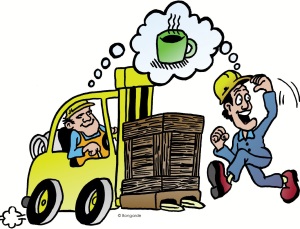Complete Powerpoint slide presentation for forklift instructors. Ready made training course
Forklift and Pedestrian Safety Tips
 Here is a really useful article by Jake Stewart, Digital Copywriter, Toyota Materials Handling.
Here is a really useful article by Jake Stewart, Digital Copywriter, Toyota Materials Handling.
Forklift operators have two critical jobs to account for in addition to their daily tasks: keeping themselves safe and ensuring pedestrian safety in their work environments. However, pedestrian safety might also be increased if non-operators take simple precautions when walking in areas of forklift use. Ultimately, it’s about developing a culture of communication and awareness that keeps everyone safer in any environment. Here are some ideas that you can explore to potentially make your work space safer.
Operator and Pedestrian Training
- Operators should yield the right of way to pedestrians: This is an OSHA recommendation, (and HSE), that all forklift drivers should be aware of. Because of the size and power of the forklift, operators should stop and wait for pedestrians to clear the area before proceeding along their route with caution.
- Pedestrians should never assume that a forklift operator sees them: While pedestrians have the right of way in forklift operating areas, that doesn’t mean an operator will always see them. A pedestrian should keep his or her eyes on a moving forklift whenever in its vicinity.
- Operators and pedestrians should have a clear system of hand signals for communication: Developing a system of hand signals, such as a pedestrian always pointing in the direction they intend to walk in a facility or an operator using their hand to signal the direction of a turn, helps to increase communication and awareness. It’s important to make sure that this system of communication is known to all associates and visitors in order to avoid confusion.
- Operators should obey OSHA guidelines when operating a forklift: It’s not just the responsibility of the pedestrian to reduce the risk of accidents, operators need to be trained to handle various situations as well. Be sure to stop, honk the horn, and proceed cautiously at intersections to warn pedestrians of the forklift’s presence. All travel and braking should be performed smoothly and in a controlled manner. When vision is impaired, be sure to use a spotter and travel in reverse if a load is blocking forward visibility. Your operator’s manual has tips for safe operation pertaining to your specific forklift. Be sure to read and understand these guidelines prior to operating your forklift.
Facility Design
- Optimize visibility for your unique environment: We can’t really tell you exactly how to optimize for high visibility. But we can tell you that doing an audit to figure out where blind spots are and where there are opportunities for improved visibility is important. Do you need mirrors to show blind spots at intersections? Do you need some warehouse redesign to eliminate blind turns? Or maybe a detection system that can notify operators of a pedestrian’s presence or pedestrians of the presence of a forklift? All of these are options for your facility’s unique needs.
- Clearly marked walkways: Identifying separate paths of travel for pedestrians as well as forklifts can help to improve traffic flow and reduce the likelihood of both being in the same location at the same time. Physically separating these paths using railings or barriers adds an extra level of separation. While this separation is ideal, it cannot always be attained. When forklift and pedestrian paths are shared, make sure there is adequate walking space on the side of forklift lanes and walkway striping on the floor.
- Audio/visual indicators: Clear signage should be used as necessary to indicate the operation of powered industrial equipment or other hazards as necessary. In some cases, audible warnings may be more effective depending on the noise level and conditions of the surrounding environment.
Equipment
- Properly maintain and repair your forklifts: Proper forklift maintenance is key to not only avoiding costly repairs, but also keeping it running in proper condition and prevent avoidable accidents. Hydraulic leaks, for example, can create slippery spots on the floor and cause loss of control of hydraulic functions. Worn out brakes can increase stopping distances. These are just a few of the potential issues that can be avoided by properly inspecting and maintaining your forklifts on a daily basis. If a potential issue is detected, the forklift should go through proper lock-out, tag-out procedures until it is repaired.
- Equip your forklifts with the proper accessories: While Toyota forklifts are rigorously designed with safety in mind, there are some accessories that can be added to a forklift to make pedestrians more aware of their location. Accessories vary by application and often include back-up alarms, flashing lights/strobes/rotating beacons and rearview mirrors.
- Equip your forklifts with the proper, authorized attachments: Forklift attachments will affect your forklift’s load handling capabilities. Utilizing the right tool for the job will not only increase efficiency, but can also reduce the likelihood of a dropped or spilled load. Be sure that any attachment you are using is approved by the original equipment manufacturer of the forklift and the data plate accurately reflects the forklift’s current condition and attachments. The data plate informs operators of the forklift’s capabilities and current configuration, so any inaccuracies can result in improper operation of the forklift.
Disclaimer. The legislative information contained on this web site is my interpretation of the law based on many years in the health and safety business. A definitive interpretation can only be given by the courts. I will therefore not be held responsible for any accident/incident/prosecution arising as a consequence of anyone using any information obtained from this web site.